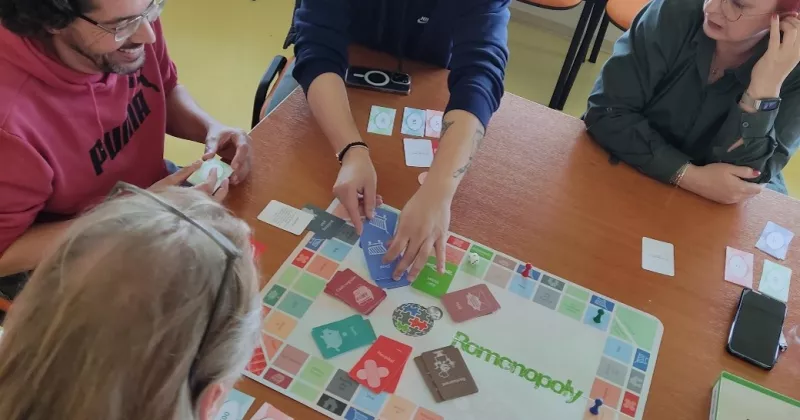Language Learning Styles
5 min read- like, share, comment!
First published in Polish by Dorota Kondrat
When one mentions learning styles, a disclaimer is needed: this is a wide-ranging topic. It is so because of the sheer number of learning style classifications (Coffield et al. identify as many as 71 of them). This can baffle any teacher. What is more, the topic has enjoyed a lot of publicity, not only in the education sector. Learning styles are related to numerous thinking styles/cognitive theories and research into intelligence components.

Photo by: Pixabay/athree23
For example, Witkin's field independence-dependence cognitive style theory is revealing. According to tests, persons categorised as field-dependent find it difficult to distinguish figures (or information) embedded in more complex surroundings, whereas field-independent persons will easily notice figures in a complex context. The former category of people finds it easier to extract and organise information (e.g. new word meanings, grammatical structures) from the context. They focus their attention on important things and are more creative. The latter category is easily distracted by irrelevant information and can have difficulty concentrating and thinking independently. In the context of education, this concept is not very constructive and leads to judgement, which can be harmful to students. Research in cultural psychology shows that field dependence is more of a social style: the western world is more analytical, whereas the Far East is more holistic. The former values individualism and the latter is the opinion of a master.
Kolb's division offers more possibilities. According to the scholar, people can be labelled as activists who learn by doing -- learning a language only makes sense to them if they can use it to communicate with foreigners and they are not bothered by linguistic theories; reflectors who learn by observing and collecting detailed data -- in language learning they like working in pairs and making analyses based on instructions; theorists who need models, diagrams and theories,-- they are keen to learn grammar and vocabulary from tables and taxonomies; pragmatists who learn for a specific purpose --they usually learn to immediately apply their knowledge in practice. However, with this taxonomy, the following questions arise: Aren’t the differences between activists and pragmatists artificially created? Do reflectors like theory or practice more? (think of grammar teaching - there are people who hate theory and only learn in context and through practice). What can be done to make theorists more active?
The third, perhaps the best-known division, is based on three sensory modalities: visual, auditory and kinaesthetic (the VAK model). This learning style model is so popular that we involuntarily define ourselves by saying: I am a visual learner. In fact, I have not met a single person who would say: I am not a visual learner or I do not remember well things that I see. Research using the Stroop colour and word test provides an explanation for that: literate people (who can read in a language they know well), when asked about the colour of a text, are immediately influenced by what is written (e.g. blue) rather than the colour of the font (red). We prefer the written word - so in learning a language, reading and writing are effective for everyone.
Since a large majority of people use the three modalities effectively, six learning preference subtypes have been identified: e.g. a visual-kinaesthetic-auditory type (learners easily learn by observing others, taking notes and using them); or an auditory-kinaesthetic-visual type (learners mainly learn in the course of a discussion and when listening to others speak. They have an extensive vocabulary and are less keen on reading), etc. It is hard to imagine backing such a division by research. Moreover, there is too much literature that debunks the myth of modal preferences and related learning styles, including publications showing that there is no accuracy in identifying them by teachers and students themselves. In 2002, the OECD announced that thinking styles were nothing but a neuromyth.
However, there is no doubt that we differ in terms of personality and cognitive abilities. So instead of learning styles, it is better to use the term of learning strategies -- in the sense of metacognition rather than a specific classification. A teacher can observe students’ personality traits, such as openness to new experiences (such people are more interested in exploring new things and learning), conscientiousness (the higher it is, the more discipline and perseverance in the learning process), neuroticism (neurotic people worry a lot, do not believe in themselves, and are very concerned about criticism), or extroversion (extrovert students like to talk a lot, are loud and playful). Being aware of these individual differences allows you to modify your work with students. Introverts can be encouraged to learn by providing them with interesting facts about culture and language or by talking about their interests. Less diligent students need to be monitored more closely. They should be given more often homework at a moderate level of difficulty. They can be shown how to achieve success by taking small steps. A neurotic learner should be given lots of positive reinforcement, etc.
A cognitive approach to teaching is the best way of working with adult learners. Learning does not start with what an educator says, but with what a learner thinks, so the observation of cognitive processes, such as memorising, paying attention, imagining things, and drawing conclusions, should be encouraged. It is beneficial if a teacher talks with a learner and together they adopt a learning strategy based on the learner's reflections and activity. For example, when teaching grammar, you can decide with learners what chunks of the theory are acceptable to them; you can agree on how learners process knowledge; discover if they can draw conclusions on their own; whether they need to be helped in doing so or whether they have enough knowledge (e.g. knowledge of other languages) to find analogies; how many examples they need to be given; whether they can come up with their own examples quickly; whether they need to write things down or maybe they prefer to talk a lot in order to memorise vocabulary; or whether they break the knowledge into smaller portions or not. The topic of learning strategies is extensively discussed in the textbook by Ledzinska and Czerniawska, as cited below.
Bibliography:
- Coffield, F., Moseley, D., Hall, E., Ecclestone, K. (2004). Learning styles and pedagogy in post-16 learning. A systematic and critical review. London: Learning and Skills Research Centre.
- Ledzińska, M., Czerniawska, E. (2011). Psychologia nauczania. Ujęcie poznawcze. Wydawnictwo Naukowe PWN. Warszawa.
- Papadatou, M., Gritzali, M., Barrable, A. (2018). The Learning Styles Educational Neuromyth: Lack of Agreement Between Teachers' Judgments, Self-Assessment, and Students' Intelligence. Frontiers in Education 29, Nov. https://doi.org/10.3389/feduc.2018.00105
- Willingham, D.T., Hughes, E.M., Dobolyi, D.G. (2015). The Scientific Status of Learning Styles Theories. Society for the Teaching of Psychology, June 17 https://doi.org/10.1177/0098628315589505
Comments
Znakomite i dowcipne…
Znakomite i dowcipne podsumowanie mojego tekstu, dziękuję :)
Bardzo dobrze!
Dawno nie miałem takiego napięcia czytając artykuł ;-) Cały czas się bałem, że w puencie pojawi się coś o dopasowaniu do wzrokowego kanału uczenia się czy podobne cudo. Na szczęście jest rzetelnie, brawo!
Dziękuję. W pewnym sensie…
Dziękuję. W pewnym sensie artykuł dedykuję samej sobie, zachwyconej 20 lat temu ideą stylów uczenia się. Jak to dobrze, że człowiek może się całe życie uczyć i zmieniać poglądy ;)






Magia stylów w środowisku edukacyjnym
Wspominanie "stylów edukacyjnych" w środowisku edukatorów rzeczywiście czasami podnosi temperaturę dyskusji (to przez tych wzrokowców, słuchowców i kinestetyków). Zapytałem nawet Ulę Dąbrowską, autorkę książki o mózgu, jak to jest z tym wzrokowcami. W odpowiedzi usłyszałem pytanie jak nawiguję po mieście - czy pamiętam zapach poszczególnych miejsc (jak pies) czy może co w nich słychać... Wyobrażacie sobie, że tłumaczysz komuś drogę: "jak poczujesz smród śmietnika, to skręć w prawo, potem idź aż zapach pieczywa stanie się wyraźny"?
A tak na poważnie, to dla mnie klasyfikowanie ludzi i ich zachowań, nawyków można uprawiać na różne sposoby. To jak rzutowanie obiektów na różne płaszczyzny. Pytanie jednak czy i jak to wpływa na uczenie się i czy praktycznie da się taką wiedzę wykorzystać, żeby polepszyć warsztat pracy edukatora. Myślę, ze kluczowy jest wniosek, że ludzie uczą się różnie, bo to pozwala nam uniknąć równie podświadomego, równie częstego co zgubnego przekonania, że uczą się tak jak my sami.